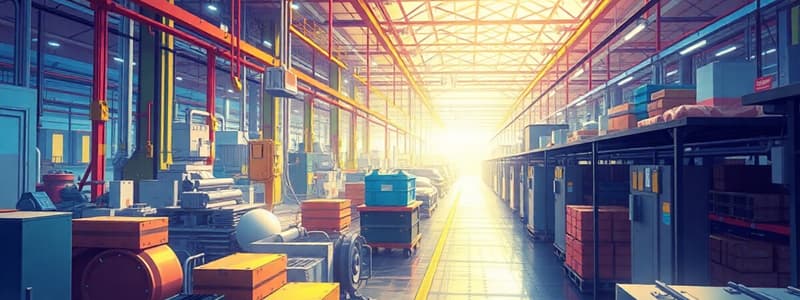Podcast
Questions and Answers
Which aspect of manufacturing systems primarily focuses on the maintenance of equipment?
Which aspect of manufacturing systems primarily focuses on the maintenance of equipment?
- Operations (correct)
- Information Systems
- Physical Systems
- People
What role do manufacturing execution systems (MES) primarily play in manufacturing?
What role do manufacturing execution systems (MES) primarily play in manufacturing?
- They provide financial insights.
- They track inventory levels and production rates. (correct)
- They manage human resources.
- They are used for designing products.
Which of the following is NOT considered a physical system in manufacturing?
Which of the following is NOT considered a physical system in manufacturing?
- Production Planning (correct)
- Machinery
- Material Handling Systems
- Warehouses
Which aspect of manufacturing is concerned with enterprise resource planning (ERP) systems?
Which aspect of manufacturing is concerned with enterprise resource planning (ERP) systems?
What is the main focus of inventory management within the operations aspect of manufacturing systems?
What is the main focus of inventory management within the operations aspect of manufacturing systems?
Which role is primarily responsible for making decisions to improve manufacturing processes?
Which role is primarily responsible for making decisions to improve manufacturing processes?
Which of the following technologies assists with the design phase of manufacturing?
Which of the following technologies assists with the design phase of manufacturing?
What is the total processing time per unit for Option 1?
What is the total processing time per unit for Option 1?
How many total minutes of daily production time are required for Option 2?
How many total minutes of daily production time are required for Option 2?
Which processing option is more efficient based on the calculation?
Which processing option is more efficient based on the calculation?
What is the maximum processing time for either A or B in Option 2?
What is the maximum processing time for either A or B in Option 2?
How does the total processing time for unit C impact the overall efficiency in both options?
How does the total processing time for unit C impact the overall efficiency in both options?
What is the primary role of the production function in an integrated manufacturing system?
What is the primary role of the production function in an integrated manufacturing system?
Which function of an integrated manufacturing system is responsible for strategic decision-making?
Which function of an integrated manufacturing system is responsible for strategic decision-making?
If an integrated manufacturing system operates for 8 hours and has 30 minutes scheduled downtime and 15 minutes unexpected downtime, what is the actual production time?
If an integrated manufacturing system operates for 8 hours and has 30 minutes scheduled downtime and 15 minutes unexpected downtime, what is the actual production time?
Which of the following best describes integrated manufacturing systems?
Which of the following best describes integrated manufacturing systems?
What is the utilization rate of the integrated manufacturing system calculated as?
What is the utilization rate of the integrated manufacturing system calculated as?
How many springs can an integrated manufacturing system produce in 435 minutes at a rate of 5 springs per minute?
How many springs can an integrated manufacturing system produce in 435 minutes at a rate of 5 springs per minute?
What component of integrated manufacturing systems is responsible for planning and drawing products and parts?
What component of integrated manufacturing systems is responsible for planning and drawing products and parts?
What is the primary purpose of the management function within an integrated manufacturing system?
What is the primary purpose of the management function within an integrated manufacturing system?
If component A requires 3 minutes per unit and component B requires 2 minutes per unit, how much total time is needed for one unit of both components?
If component A requires 3 minutes per unit and component B requires 2 minutes per unit, how much total time is needed for one unit of both components?
How is 'planned downtime' best defined in the context of integrated manufacturing systems?
How is 'planned downtime' best defined in the context of integrated manufacturing systems?
Flashcards
Physical Systems in Manufacturing
Physical Systems in Manufacturing
It includes the physical structures used for manufacturing, like buildings, warehouses, and the equipment used to transform raw materials into finished goods.
Production Planning and Scheduling
Production Planning and Scheduling
It involves planning what products to make, in what quantities and when. It includes scheduling equipment and personnel to meet deadlines.
Process Design in Manufacturing
Process Design in Manufacturing
It involves determining the sequence of steps to transform raw materials into finished goods.
Inventory Management
Inventory Management
Signup and view all the flashcards
Quality Control in Manufacturing
Quality Control in Manufacturing
Signup and view all the flashcards
Maintenance in Manufacturing
Maintenance in Manufacturing
Signup and view all the flashcards
Enterprise Resource Planning (ERP) Systems
Enterprise Resource Planning (ERP) Systems
Signup and view all the flashcards
Integrated Manufacturing System
Integrated Manufacturing System
Signup and view all the flashcards
Production Function
Production Function
Signup and view all the flashcards
Design Function
Design Function
Signup and view all the flashcards
Management Function
Management Function
Signup and view all the flashcards
Strategic Planning Function
Strategic Planning Function
Signup and view all the flashcards
Utilization Rate
Utilization Rate
Signup and view all the flashcards
Processing Time
Processing Time
Signup and view all the flashcards
Process Flow
Process Flow
Signup and view all the flashcards
Integrated Manufacturing System (IMS)
Integrated Manufacturing System (IMS)
Signup and view all the flashcards
System Efficiency
System Efficiency
Signup and view all the flashcards
Sequential Processing
Sequential Processing
Signup and view all the flashcards
Parallel Processing
Parallel Processing
Signup and view all the flashcards
Total Processing Time per Unit
Total Processing Time per Unit
Signup and view all the flashcards
Daily Production Time
Daily Production Time
Signup and view all the flashcards
Most Efficient Process
Most Efficient Process
Signup and view all the flashcards
Study Notes
Manufacturing Systems Aspects
- Manufacturing systems are defined by physical systems, operations, information systems, and people.
Physical Systems
- Facilities: Buildings, warehouses, and structures housing the manufacturing process.
- Equipment: Machinery, tools, and assets used to transform raw materials into finished products.
- Material Handling Systems: Equipment and processes moving materials within the facility (e.g., conveyor belts, robots, forklifts).
Operations
- Production Planning and Scheduling: Determining what products to make, in what quantities, and when. Includes scheduling equipment and labor.
- Process Design: Planning the sequence of steps to transform raw materials into finished products.
- Inventory Management: Efficient ordering, storage, and use of materials.
- Quality Control: Ensuring products meet required standards.
- Maintenance: Keeping equipment and machinery in good working order.
Information Systems
- Manufacturing Execution Systems (MES): Systems collecting and tracking data from the manufacturing process (e.g., production rates, machine downtime, inventory levels).
- Enterprise Resource Planning (ERP) systems: Systems integrating information from all business aspects (manufacturing, finance, sales).
- Computer-Aided Design (CAD) and Computer-Aided Manufacturing (CAM): Technologies used to design products and create instructions for manufacturing.
People
- Workers: Personnel operating equipment and performing tasks to produce goods.
- Managers: Individuals overseeing the manufacturing process and making decisions for improvement.
- Engineers: Professionals designing and developing new products and manufacturing processes.
Manufacturing Systems Structure
- The structure includes hierarchical levels from enterprise to station, relating to strategic resources, strategies, and operational rules.
Manufacturing Systems Transformation
- Key advancements in manufacturing, such as Toyota Production Systems (TPS), Flexible Manufacturing Systems (FMS), and Reconfigurable Manufacturing Systems (RMS) are discussed.
- There is an increase in system flexibility, responsiveness, and efficiency over time.
- Cloud-based manufacturing systems (CBMS) are also mentioned.
Integrated Manufacturing Systems
- Computer-Integrated Manufacturing (CIM) is defined as a manufacturing approach utilizing computer-controlled machinery and automation.
- The four major functions in an integrated system are production, design, management, and strategic planning.
Integrated Manufacturing Systems Calculations
- An example of calculating utilization rate for producing car suspension springs in a manufacturing system is provided.
- Calculations of total available production time, actual production time, total springs produced, and the utilization rate of an integrated manufacturing system are shown.
- Another example features a system assembling three components (A, B, C).
- Option 1 (sequential processing) and Option 2 (parallel processing) are analyzed in terms of daily production time.
Studying That Suits You
Use AI to generate personalized quizzes and flashcards to suit your learning preferences.




